Introduction
Langgam Jawa songs were likely first played by kroncong ensembles in the 1950s (Yampolsky Reference Yampolsky1991). Kroncong ensembles consist of stringed instruments, many of which were introduced to the archipelago now known as Indonesia by the Portuguese in the 16th century (Yampolsky Reference Yampolsky2013a, Reference Yampolsky2013b). The current ensemble includes a pair of ukulele-like instruments known as cuk and cak, guitar, upright bass, violin, flute, and a plucked cello known as a selo. Footnote 1 Kroncong ensembles play a variety of song forms including kroncong asli, langgam kroncong, and stambul. Footnote 2 It is also common to hear groups playing popular songs from other genres, such as pop or rock, using kroncong instrumentation. All of the aforementioned song forms use diatonic scales and chords and typically use Indonesian language. In addition to these repertoires, however, many kroncong ensembles play langgam Jawa songs that are sung in Javanese language.
We define langgam Jawa as a 32-bar form using A–A’–B–A’ with each section consisting of eight bars. Instead of using a system of functional tonic-dominant harmony, the music in langgam Jawa kroncong is arranged modally as approximations of the gamelan slendro and pelog pentatonic scales. The pelog nem mode used in gamelan is represented by the numbers 6, 1, 2, 3, and 5 in cipher notation which is approximated by G, B, C, D, and F# in langgam Jawa kroncong arrangements.Footnote 3 In arrangements of slendro songs, 1, 2, 3, 5, and 6, in gamelan cipher notation for slendro manyura are approximated by the diatonic notes G, A, C, D, and E in langgam Jawa kroncong arrangements.Footnote 4
There is still some debate as to whether the song form of langgam Jawa originates in gamelan or kroncong. Gamelan musicians that we interviewed usually assert that langgam Jawa emerges from the ketawang song form in gamelan music.Footnote 5 Meanwhile, kroncong musicians believe that it can be traced back to langgam kroncong, a 32-bar A–A’–B–A’ song form in kroncong repertoire that uses diatonic scales and Indonesian language. Langgam Jawa has also been played in more traditional gamelan settings since about as long as the repertoire has been played by kroncong ensembles so it is difficult to say definitely.Footnote 6
Kroncong musicians in Surakarta suggest that the rhythmic patterns and techniques of the selo in langgam Jawa kroncong imitate those of the kendhang in gamelan music. Kendhang (alternatively kendang) is a generic term for any double-headed laced drum found mainly on the islands of Java and Bali (Kartomi et al. Reference Kartomi, Heins and Ornstein2001). In Central Java, the kendhang is played by hand and this word is used as an umbrella term for four drums: the smallest known as the ketipung, the mid-sized drum known as ciblon, another mid-sized drum called sabet, which is used for wayang kulit (traditional shadow theatre), and the largest known as ageng or kendhang bem/gendhing. Despite imitating the kendhang, the rhythmic patterns for selo playing in langgam Jawa are distinct (see McGraw Reference McGraw2022), and the techniques used are necessarily different based on the limitations and affordances of the instrument itself. While playing the selo, a musician can produce a musical pitch by playing the strings or produce rhythmic sounds by striking the strings or the body of the selo. The kendhang, on the other hand, only allows for rhythmic sounds although approximations of musical pitches can be made by tuning the drum heads.Footnote 7 Within their respective ensembles, the selo and the kendhang are both responsible for cuing beginnings and endings of both the entire piece and sections therein, the number of repetitions, and controlling the tempo meaning that both instruments play similar roles within the ensemble.
Each instrument in a kroncong ensemble, in fact, is said to be inspired by the role of a gamelan instrument: the cak is said act as the siter, the cuk as the bonang, the guitar as the gambang, the upright bass as a gong, the violin as the rebab, and the flute as the suling. Footnote 8 By the 1960s, however, techniques for imitating langgam Jawa kroncong using gamelan instruments began to emerge, bringing this musical exchange full circle. This is when shadow puppeteer (dhalang) and musician, Ki Nartosabdho (1925–1985), developed a style of kendhang playing that imitates the selo, often called kendhang gaya selo (selo-style drumming). All eight of the drummers we interviewed cited his recordings as influential to their playing and all believed him to be the pioneer of this style of drumming.Footnote 9 Ki Nartosabdho is also arguably one of the most influential and prolific figures in terms of gamelan settings of langgam Jawa.
In this article, we contrast kendhang gaya selo with kendhang pematut, Footnote 10 a flexible, more general style of drumming based on recordings we made of selo and kendhang players. Pematut comes from the Javanese word patut, which means “in agreement with,” “fitting,” or “suitable.” When drummers use pematut, this means that they adjust their playing to be suitable to the performance context, to the listeners present, to the players included in the ensemble, and to the melody and structure of the song. Drummers using kendhang gaya selo also make contextual adjustments, but gaya selo patterns are more specific and fixed. When we say “pematut” in this article we mean pematut-style drumming for langgam Jawa. This is important because pematut differs depending on the form (lancaran, ladrang, etc.) being played. In our research, we found that drummers made aesthetic choices about whether to use kendhang gaya selo or pematut with an aim to create contrast variation and balance not only within the course of a single event but also within a single piece of music.
Although there is mutual musical exchange between langgam Jawa settings of kroncong and gamelan, it is extremely rare to meet musicians who play both styles. McGraw writes that “[t]he two forms reside in rather different social worlds. Historically, gamelan is associated with the aristocracy and ostensibly autochthonous expressive forms, while kroncong is associated with colonial-era cultural hybridity” (Reference McGraw2022:115). It is extremely rare for selo players to play kendhang regularly as well.
Within ethnomusicology, Central Javanese gamelan has long been a topic of scholarly interest, and there are numerous works dealing with tuning, structure, and the role of gamelan in society. This article aims to complement and extend detailed studies of Central Javanese kendhang (Pickvance Reference Pickvance2005; Brinner Reference Benjamin2008; Pietrosanti Reference Pietrosanti2014; Setiawan Reference Setiawan2018; Aji and Suyoto Reference Aji2022; McGraw Reference McGraw2022). Kroncong, however, has received considerably less scholarly attention. Some scholars discuss the styles of kroncong using equal-tempered, diatonic scales sung in Indonesian language, as in kroncong asli or stambul, for example, but only a few works engage with langgam Jawa kroncong (Yampolsky Reference Yampolsky1991, Reference Yampolsky2013a, Reference Yampolsky2013b; Sugiyanto Reference Sugiyanto2003; Skelchy Reference Skelchy2015) or focus exclusively on langgam Jawa kroncong (Nuswantoro Reference Nuswantoro2013; Riasetyani Reference Riasetyani2013; Noryuliyanti Reference Noryuliyanti, Isawati and Abidin2021; McGraw Reference McGraw2022). Our work aims to add to discourses regarding langgam Jawa kroncong, as well as the broader repertoire of langgam Jawa. Apart from McGraw (Reference McGraw2022), to the best of our knowledge, there are no other sources in Indonesian or English language that discuss selo-style kendhang in langgam Jawa.
Our work will also join a small but steadily growing body of literature in ethnomusicology that combines first-hand accounts from culture bearers with outsider ethnographic interpretations. Two of the authors are faculty in the Gamelan Department (Jurusan Karawitan) at the Indonesian Arts Institute of Surakarta (Institut Seni Indonesia Surakarta, ISI Surakarta). The third author is a PhD candidate living in the United States who has studied gamelan and kroncong in Surakarta since 2014. This research is reflective of not only a decade of collaboration between the researchers themselves, but also of many years of engagement with the studied music and communities. Instead of a restricted period of ethnographic study, this project adopts a “continuous process of studying and reassessing the community within which researchers engage” (Bruinders and Kunnuji Reference Bruinders and Kunnuji2022:43).
Ki Nartosabdho and Kendhang Gaya Selo
Although Ki Nartosabdho is best known as a shadow puppeteer and gamelan musician, most of the eight musicians we interviewed were also aware of his background in kroncong music. This has also been confirmed in interviews with Ki Nartosabdo (see Sutton Reference Sutton1996). In his youth, he learned several instruments in the kroncong style including the selo, guitar, violin, and the cuk. Ki Nartosabdho claims to have never become particularly advanced with any of these instruments (Sutton Reference Sutton1996:347) but these early experiences, not only exposure to selo playing but immersion and effort to learn the instrument, could be a factor that influenced his development of kendhang gaya selo. When Ki Nartosabdho joined a theatre group known as Ngesthi Pandhawa in 1945, a pivotal move in his career, he performed as a drummer and went on to drum on many of the recordings that he made.
Ki Nartosabdho was also well-known as a composer, penning hundreds of new gamelan vocal pieces, many of which he played with his group Condhong Raos, founded in the late 1960s. Starting in the early 1970s, Ki Nartosabdho made dozens of recordings. Some of his compositions were adaptations of pre-existing pieces, and others used traditional gamelan musical forms such as ladrang or ketawang, yet he was also a prolific langgam Jawa composer. Some of his langgam Jawa compositions include “Kelinci Ucul” (“Stray Rabbit”), “Ojo Lamis” (“Don’t Be Insincere”), “Ngujiwat” (“Meaningful Sidelong Glance”), and “Impenku” (“My Dream”). In many recordings of these pieces, Ki Nartosabdho uses kendhang gaya selo and it is important to note that Ki Nartosabdho only used this drumming style for langgam Jawa repertoire. We know that the 1960s marked his earliest recordings of kendhang gaya selo, but that he was likely using this rhythmic treatment in live performances before this time.
In the same way that each of the instruments in the kroncong ensemble imitates the roles of gamelan instruments for langgam Jawa repertoire, certain gamelan instruments also change roles during kendhang gaya selo. The bonang, instead of playing interlocking patterns called imbal, plays patterns using “octaves” known as kemprungan. One of the authors compared kemprungan in this instance to the interlocked patterns of the cuk and cak in kroncong albeit in diatonic kroncong forms such as kroncong asli or langgam kroncong as the cuk and cak do not interlock in langgam Jawa kroncong. The saron panerus (also known as peking) imitates the patterns of the cak in langgam Jawa (generally repeated ascending and descending patterns) during kendhang gaya selo. These observations are interesting because the cak in langgam Jawa kroncong imitates the siter from gamelan, but in many gamelan ensembles, there is already a siter filling this role. The other instruments in the gamelan ensemble remain the same for langgam Jawa repertoire accompanied by kendhang gaya selo.
We interviewed eight drummers, all of whom were men ranging in age between 32 and 76 at the time of this research. All of the drummers we interviewed cited Ki Nartosabdho as the earliest innovator of kendhang gaya selo, with most of the drummers saying that they learned the style at least in part from listening to Ki Nartosabdho’s cassettes. Drummer Pak Dwijo Martono (also known as Pak Wakidi) claims that “all of the young kendhang players that I have seen, all of them imitate Ki Narto’s kendhang playing” (interview, 13 February 2023).Footnote 11 Over fifty years after Ki Nartosabdho began making recordings with kendhang gaya selo, his particular rhythmic treatment remains the main reference for the style.
“Ngimpi”
Kendhang gaya selo is not considered suitable for all songs in the langgam Jawa repertoire in gamelan settings, and opinions vary as to which songs are most appropriate. We chose to narrowly focus on one piece from langgam Jawa repertoire called “Ngimpi” (“Dream”)Footnote 12 to consistently observe rhythmic treatment between players. The authors believe that this piece is one of a few that was widely considered suitable for kendhang gaya selo which was later confirmed in our interviews with drummers.
Langgam Jawa repertoire always features a vocalist, typically but not always female. In gamelan settings, these female singers are known as pesindhen and they perform using a florid vocal style with highly detailed ornamentation (Sutton Reference Sutton and Koskoff1987:120). In kroncong settings, the singer is called penyanyi and they use a set of embellishments, known as cengkok in both gamelan and kroncong settings, that are distinct to the genre.
Below is a translation of the Javanese lyrics of “Ngimpi”:
Sripat sripit,lembehane mrak kesimpir
The sound her of walking, swaying her arms like a peacock’s wings
Gandhes luwes, wiragane anglamlami…
Just right, graceful, her movements are stunning
Sedhet singset, besus angadi busono
Fit and shapely, well-dressed
Dhasar ayu, taksih kenyo tan kuciwo
Absolutely pretty, still young, she does not disappoint
Dak caketi, aduh mesem sepet madu
I approach her, oh my her smile is the sweetest honey
Ora sronto, ndak gandheng malah gumuyu
Soon I put my arm around her and she laughs
Katon bungah,kenyo kang pindho hapsari
She looks happy, she’s like an angel
Kuciwane, kabeh mau amung ngimpi
Sadly, it was all just a dreamFootnote 13
“Ngimpi” was written by Ki Mujoko Joko Raharjo (1940–1992) (Emerson Reference Emerson2016:89) although it is often falsely attributed to Ki Nartosabdho. Ki Mujoko Joko Raharjo was a shadow puppeteer from Klaten, a city approximately 35 kilometres south and west from Surakarta. The lyrics are from the point of view of a man describing a woman he desires, although the genders are assumed rather than made explicit by pronouns in the song.Footnote 14 Words like “ayu” or “pretty” suggest that the desired person is female along with the phrase “sedhet singset” meaning “shapely” or “well-proportioned.” This song can and is frequently sung by all genders. Ultimately, the narrator expresses a sense of disappointment because the perfect object of desire they described was merely a dream.
Figure 1 includes a transcription of “Ngimpi” in Western notation. The balungan Footnote 15 for gamelan instruments is written above the Western notation. A penyanyi kroncong would sing the notes as written in an approximation of the pelog nem mode in gamelan using diatonic pitches.
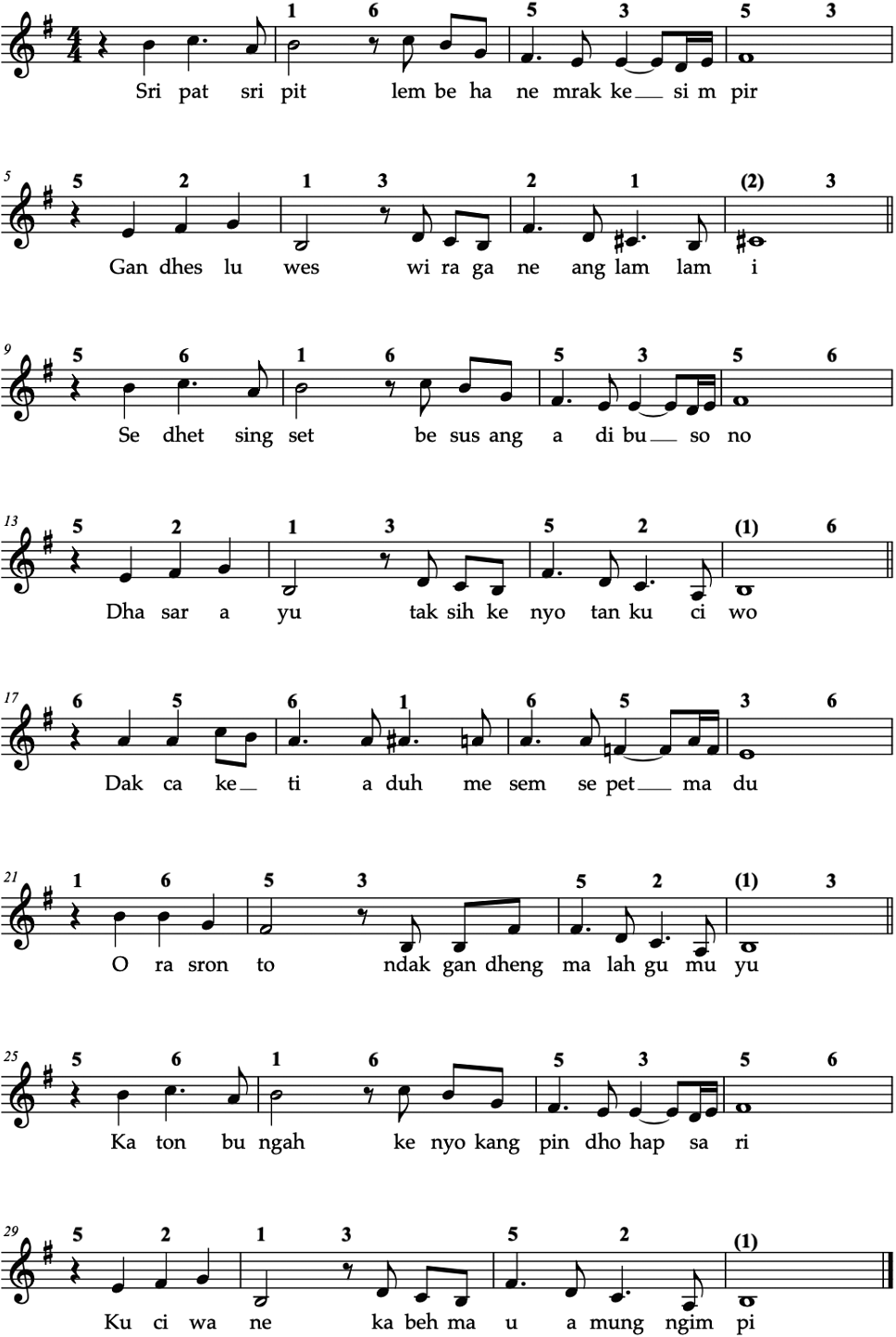
Figure 1. “Ngimpi” (“Dream”) composed by Ki Mujoko Joko Raharjo.
The Recording Process for “Ngimpi”
For this article, we compare 21 recordings of the piece “Ngimpi.” We worked with eight drummers who each did two recordings: one recording with kendhang gaya selo and one recording with kendhang pematut. We also did five recordings with selo players to serve as a baseline of comparison for the kendhang gaya selo recordings. We asked all of the performers to demonstrate two irama or temporal densities (see chapters 3 and 4 of Sumarsam 1992). For the kendhang recordings, we asked each drummer to play in irama wilet and then irama rangkep. Each selo player played in the parallel irama for langgam Jawa kroncong, known as irama engkel and irama dobel (see Yampolsky Reference Yampolsky2013b:301). Each player was also asked to cue a break or andhegan, wherein the other instruments in the ensemble slowed to a full stop. The vocalist then begins the next phrase and the selo or kendhang will cue the rest of the instruments to re-enter.
For each of these recordings, we provide partial rhythmic transcriptions and analyse relationships between patterns for the selo and the drum. We obtained verbal consent and conducted interviews with each musician in order to better comprehend how they conceive of langgam Jawa repertoire. Interviews with drummers also focused on what songs they found to be most or least appropriate for kendhang gaya selo, as well as how and when they choose to use this rhythmic treatment.
The two Institut Seni Indonesia faculty members made decisions based on their expertise in kendhang as to which drummers to include in this study. They also recommended all of the selo players in this study with the exception of Pak Giyarto, a recommendation from the third author, based on their decades of experience with langgam Jawa kroncong in Surakarta. Most of our interviewees live in or nearby Surakarta where we were all based at the time of writing this article. The selo players, Pak Edy, Pak She Doel, Pak Purwanto, Pak Giyarto, and Pak Gendul, all learned from a mix of other selo players in the community and from recordings. As there are no formal institutions for learning kroncong, none of them studied kroncong at a university. Gamelan knowledge is often passed down through hereditary lineages and Pak Suwito, Pak Joko Suranto, Pak Tlonteng, Pak Widodo, Pak Timbul, and Pak Sigit Gapuk all described their families as keluarga seniman (artist families) who played an important role in their early gamelan education. Pak Wakidi and Pak Darno descend from families that appreciated gamelan and were able to play albeit ina limited capacity, but did not go so far as to describe them as keluarga seniman. Most of the drummers we recorded spent some time studying at ISI SurakartaFootnote 16 with the exception of Pak Wakidi and Pak Tlonteng.
For kendhang gaya selo, some of the drummers chose to use only the ciblon while others played two ciblon and the kendhang ageng, which is all a matter of personal preference. In some recordings with Ki Nartosabdho, up to three drummers played during selo-style kendhang treatments while others only featured one drummer. When three drummers play selo-style kendhang, the lead drummer will playing ciblon and ketipung, another drummer will play another ketipung in a pattern called trunthungan that imitates the cuk rhythms in langgam Jawa kroncong, and the third drummer plays kendhang ageng. For the recording with Pak Suwito, one of the authors played the ketipung using trunthungan patterns. During these recordings, however, we chose to focus on the styles of individual drummers and their aesthetic decisions. The analysis in this article focuses on individual drummers using ciblon with the occasional addition of sabet.
Musical Analysis
In general, selo patterns are shorter than kendhang patterns and vary greatly among performers in part because of the lack of institutionalisation mentioned earlier. Kendhang, however, is taught in universities and six of the eight drummers than we interviewed had studied formally. Institutions play a role in formalising and naming specific kendhang patterns (McGraw Reference McGraw2022:128). There are three rhythmic patterns that we found most synonymous between the selo and kendhang playing that we observed for “Ngimpi.” The first, known as singgit in kroncong settings of langgam Jawa, is related to kenser patterns in ciblon.Footnote 17 The second rhythmic element does not have a name, but is used leading up to strong beats, particularly the last beat in each grouping of four beats known as seleh, and will be explained further below. Kroncong players refer to the third element as a fill-in among while kendhang players refer to this elements as nampani andhegan. Performers use fill-in or nampani andhegan patterns to invite the instrumentalists back in after a break or andhegan. In this instance, the singer begins with the lyrics “Katon bungah…,” and the selo or kendhang player cues that rest of the musicians to play again. Below are the eight distinct patterns that drummers used for pematut as compared with gaya selo. All of these patterns are in irama wilet which is the equivalent of irama engkel in kroncong. We created the notation below using the symbols in Figure 2.
-
1) Pak Dwijo Martono, 13 February 2023
-
2) Pak Tlonteng, 17 February 2023
-
3) Pak Sigit Gapuk, 21 February 2023
-
4) Pak Sri Eko Widodo, 22 February 2023
-
5) Pak Timbul, 21 February 2023
-
6) Pak Joko Suranto, 23 January 2023
-
7) Pak Darno, 23 January 2023
-
8) Pak Suwito, 13 January 2023
Example Corpus
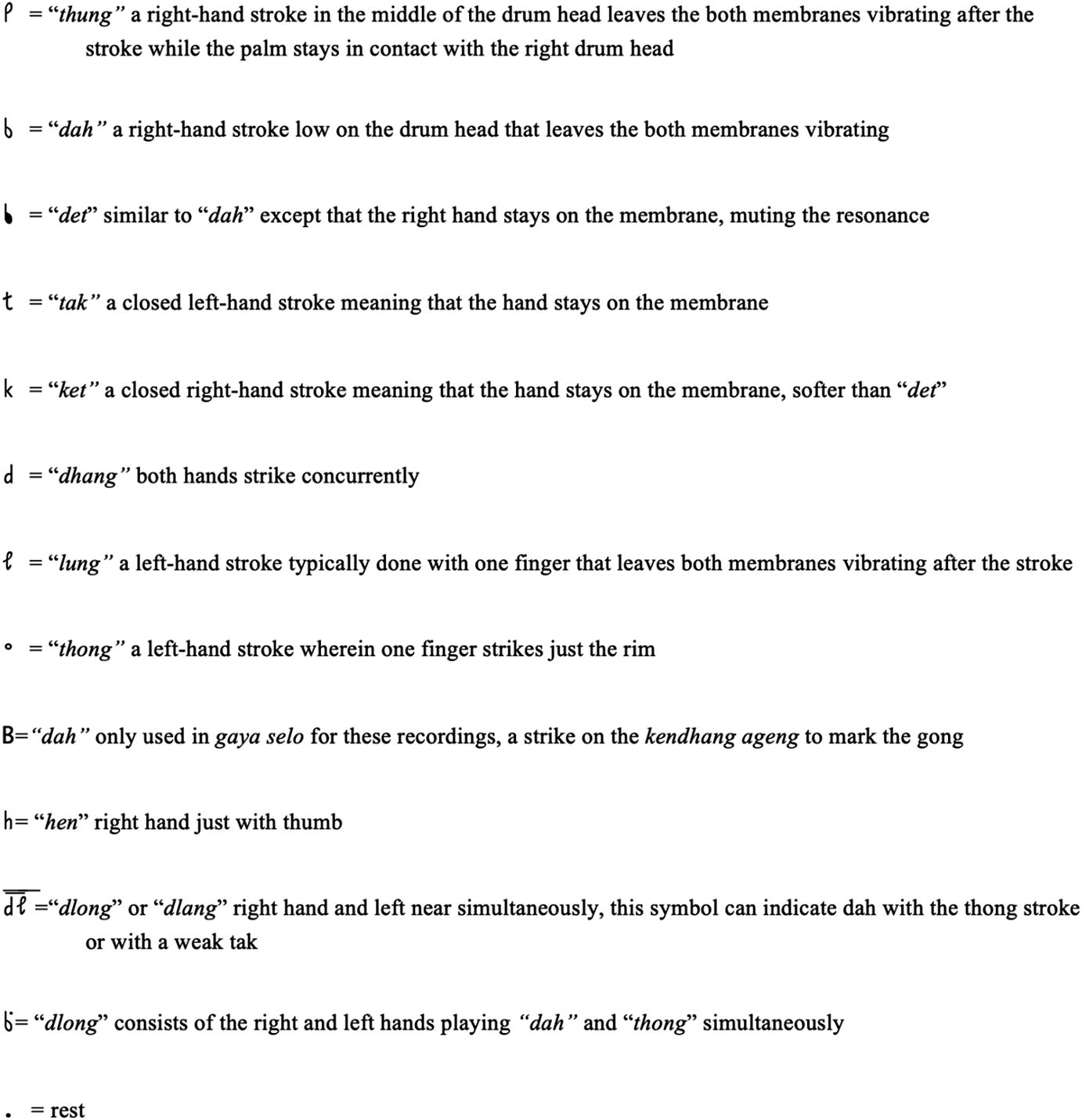
Figure 2. An explanation of technique and correlating symbols for kendhang strokes.
From these examples, and in no particular order, we can see a certain amount of variety among drummers while at time same time several patterns bear similarities (Figure 3). In particular, the pematut patterns 4 and 5 played by Pak Sri Eko Widodo and Pak Timbul respectively are fairly similar in structure although some of the drum strokes vary. Both players used a repeating “dlong thong thong” pattern. These patterns are similar to those played in Ki Nartosabdho’s group Condhong Raos and by Ki Nartosabdho himself, an indication of the influence of both Ki Nartosabdho and his group beyond simply kendhang gaya selo.
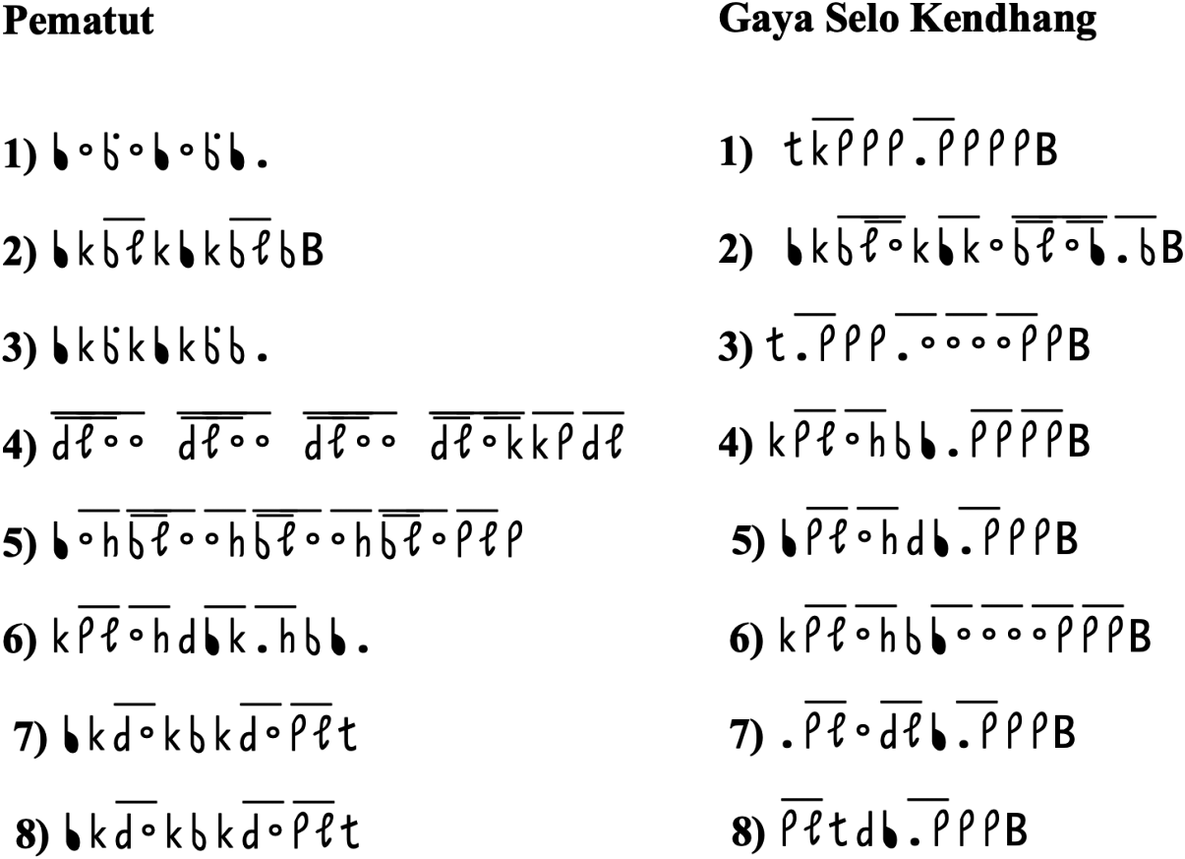
Figure 3. Examples of pematut patterns are in the left column and gaya selo kendhang patterns are in the right column.
Another similarity among the patterns for gaya selo kendhang was the use of a repeated “thung” leading up to the strong beat of the gong. All of the players used this with the exception of the second pattern which was played by Pak Tlonteng. This repeated thung before a strong beat—whether a bass note, a kenong, kempul, or gongFootnote 18—was part of what drummers identified as similar to selo playing, part of what makes selo-style kendhang sound like the selo from kroncong, a point to which we will return below after examining the patterns from the selo players in Figure 4.
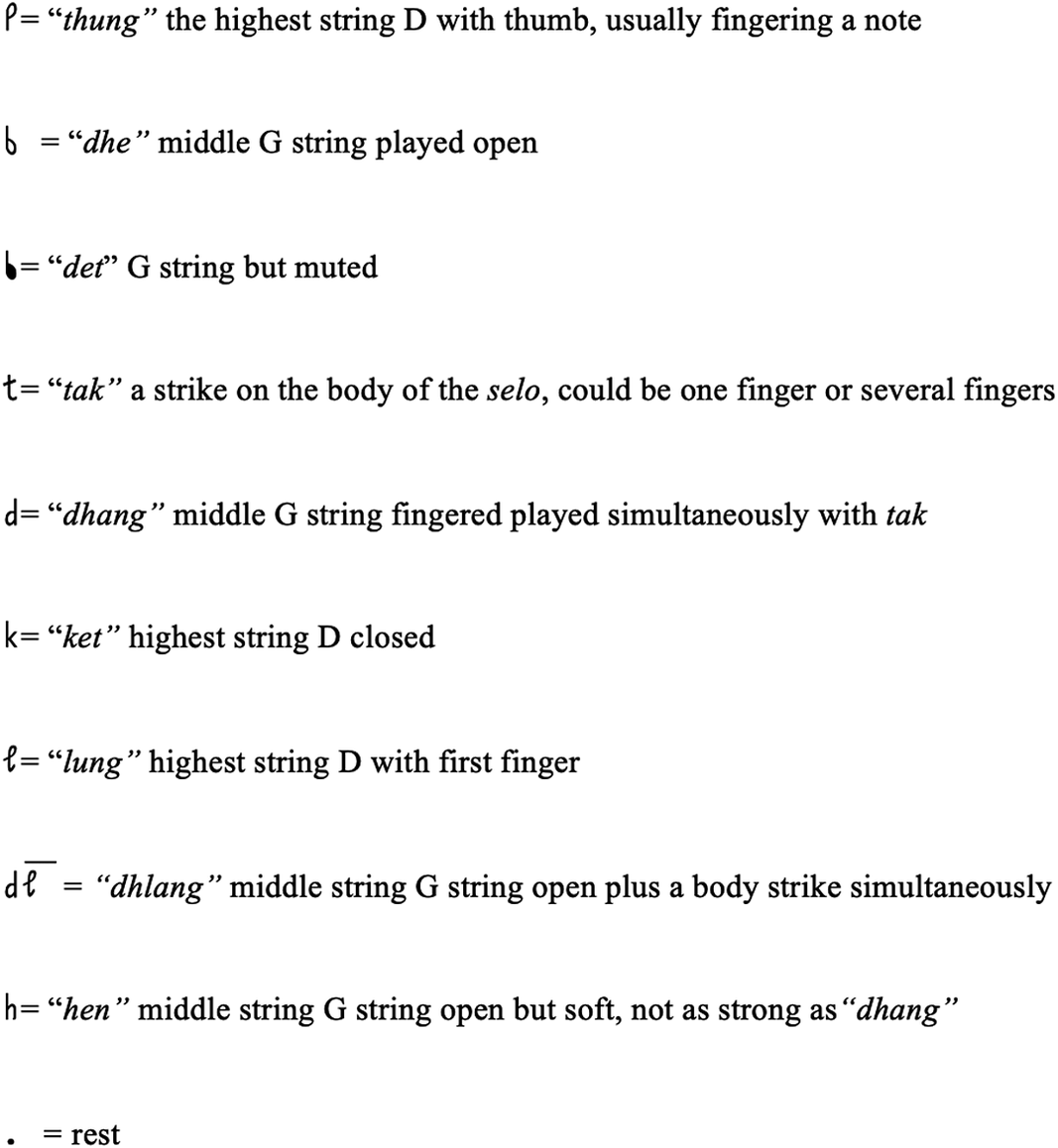
Figure 4. An explanation of technique and correlating symbols for selo strokes.
The five examples in the left column of Figure 5 are the commensurate patterns from the selo players that we recorded with the selo-style kendhang patterns for comparison. All the kroncong selo excerpts commence from the same point in the song where in the case the selo player cues the rest of the group to re-enter after a break as the vocalist sings “katon bungah.” All five examples are in irama dobel or irama rangkep. We chose to use the patterns in irama dobel/rangkep because, although the temporal density is different, more similarities are evident between the patterns used by selo players and those used by kendhang players. We also provide another key for the symbols used in the notation, in this case for the selo strokes (Figure 4). Although the strokes are basically equivalent in function, they are played differently on the selo versus the kendhang.
-
1) Pak Si Dul, 8 March 2023
-
2) Pak Gendul, 8 March 2023
-
3) Pak Edy, 24 February 2023
-
4) Pak Giyarto, 2 February 2023
-
5) Pak Si Pur, 8 March 2023
Example Corpus
Between the two columns shown in Figure 5, it is evident that the selo players perform fewer notes than kendhang players. Many of these notes, however, are quiet “thong,” “hen,” or “ket” strokes that perform a similar timekeeping function as “ghost” notes in other styles of drumming (see Polak Reference Polak2010; McGraw Reference McGraw2022:127). The first half of pattern 1 in the kroncong selo column, played by Pak Si Dul, is similar to patterns 1 and 3, played by Pak Dwijo Martono and Pak Sigit Gapuk respectively, bear some similarities although Pak Dwijo Martono uses a “ket” while the other two players use a rest. “Ket” is a quiet stroke meaning that it is unaccented, simply holding space in a way that is comparable to a rest. We found another similarity in pattern 4 in the kroncong selo column, played by Pak Giyarto, and pattern 5 in the opposing column played by Pak Timbul. Pak Giyarto uses a rest where Pak Timbul uses a thong, but once again the thong is a soft stroke with a similar holding function. Pak Darno also employs a similar rhythm as seen in pattern 7 of the kendhang gaya selo column. The drummers used a repeated thung followed by dah on the kendhang ageng, forming a similar function of leading towards the strong beat as the dhang followed dah used by Pak Giyarto on the selo.
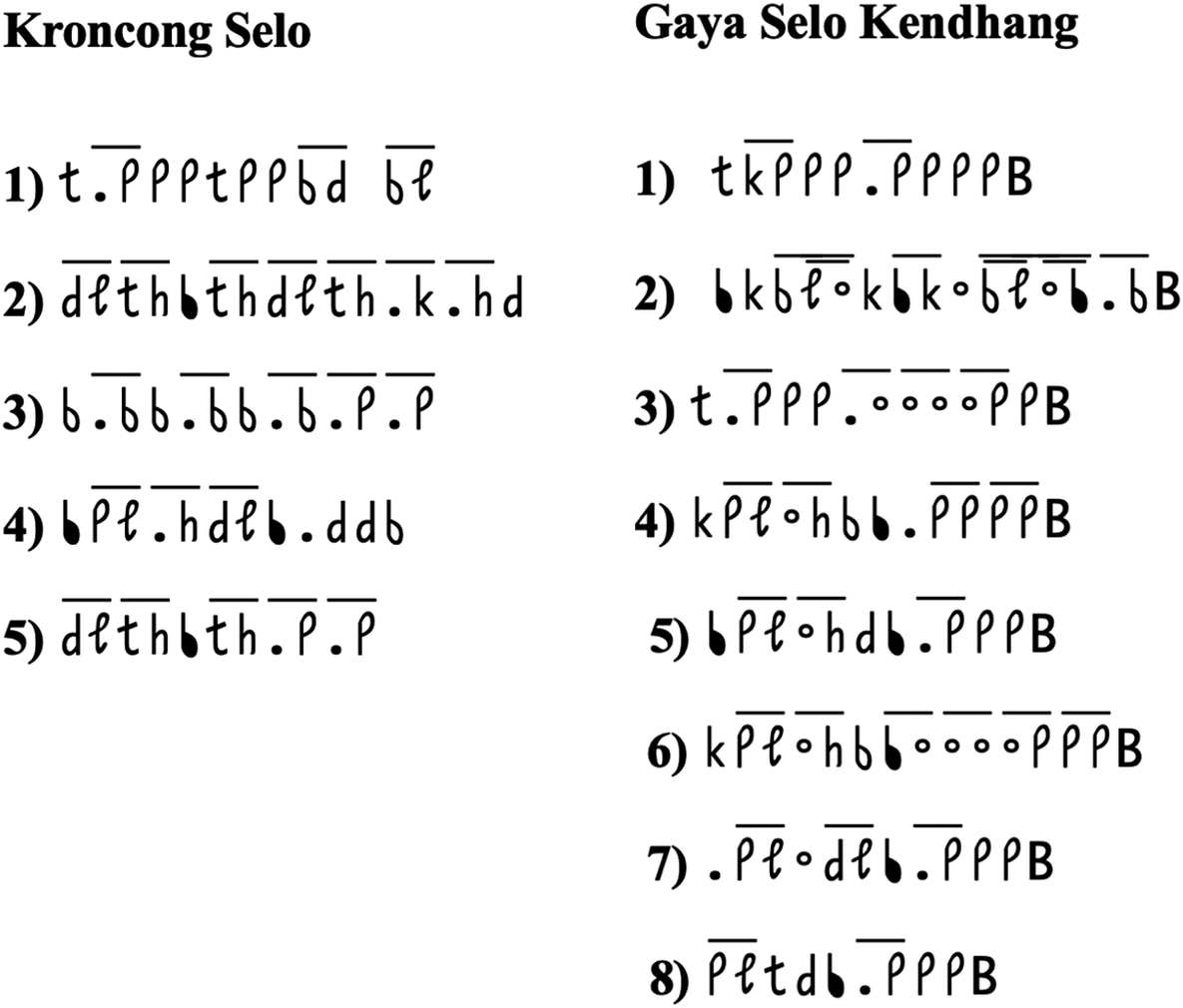
Figure 5. Examples of kroncong selo patterns are in the left column and gaya selo kendhang patterns are in the right column.
We selected Pak Suwito and Pak Edy’s recordings for full transcription. Each player that we recorded has a distinct style, but we felt that Pak Suwito and Pak Edy demonstrated the most quintessential styles for each instrument respectively. This is in part because both Pak Suiwto and Pak Edy’s playing styles are considered to be alus or refined by other musicians in Surakarta. The refinement is evident both in the patterns that they choose and the way that they play their instruments: in a subtle manner than minimises extraneous motion. While we consider all of the drummers and selo players we recorded to be experts, Pak Suwito and Pak Edy stand out and are some of the most senior players.
In Figures 6–8, the melody for the vocal line, the lyrics, the notation for gamelan, and the kendhang or selo notation are all stacked vertically. Gamelan notation, kendhang notation, and selo notation are end-weighted, meaning that the final beat of each grouping of notes is given the most emphasis. We positioned grey bars where the first and third beats of the vocal melody (front weighted) lined up with the final beats in the gamelan notation (cipher notation above the staff) and the kendhang notation or selo notation (below the lyrics). Pak Suwito and Pak Edy began playing after a solo vocal introduction, cuing the rest of the ensemble to enter on the second syllable in “sripit” where the first grey bar appears. This notation only reflects one cycle through the song form before any shifts in irama.

Figure 6. Transcription of Pak Suwito playing kendhang pematut once through the song form of “Ngimpi.”
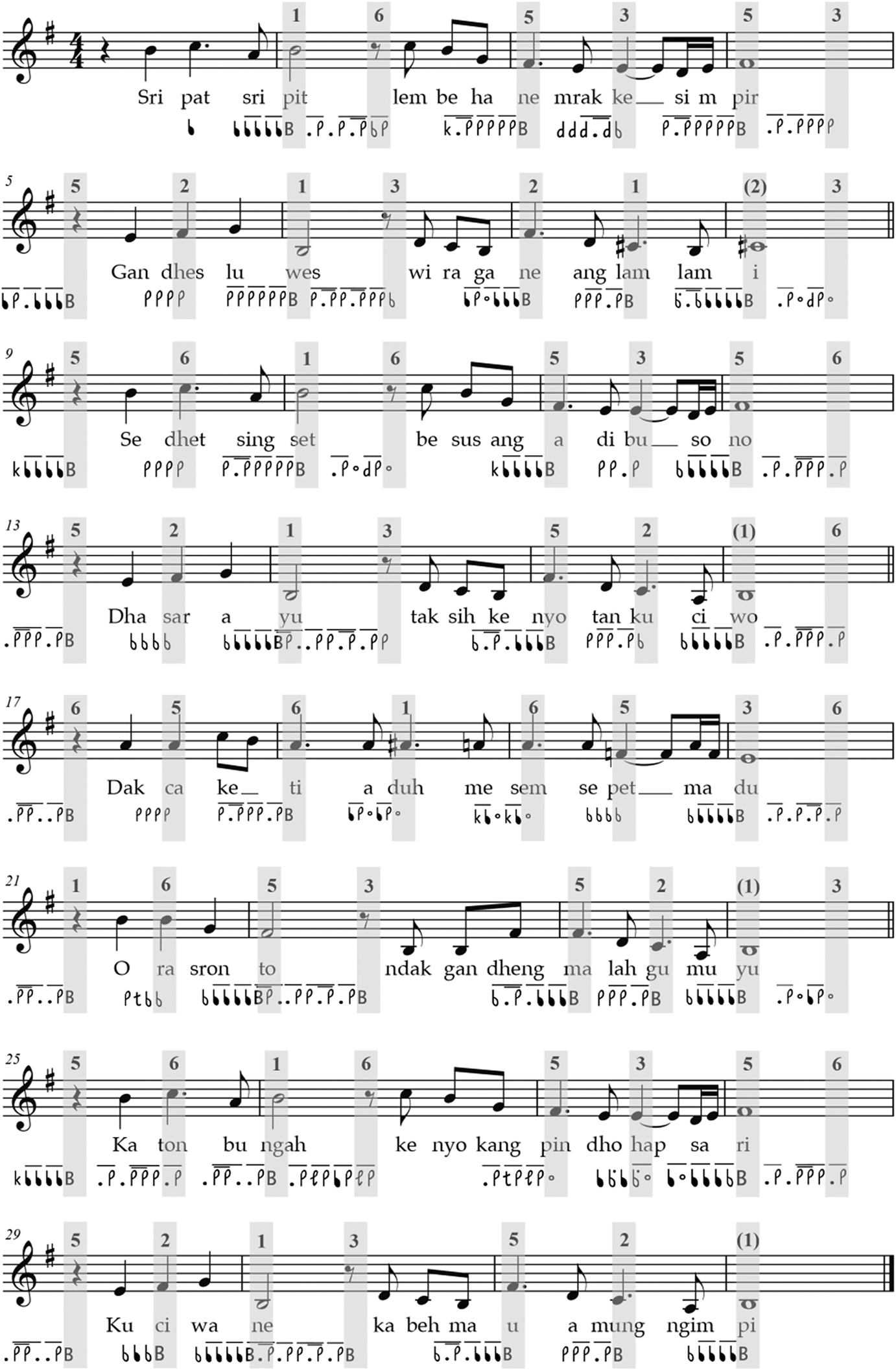
Figure 7. Transcription of Pak Suwito playing gaya selo kendhang once through the song form of “Ngimpi.”
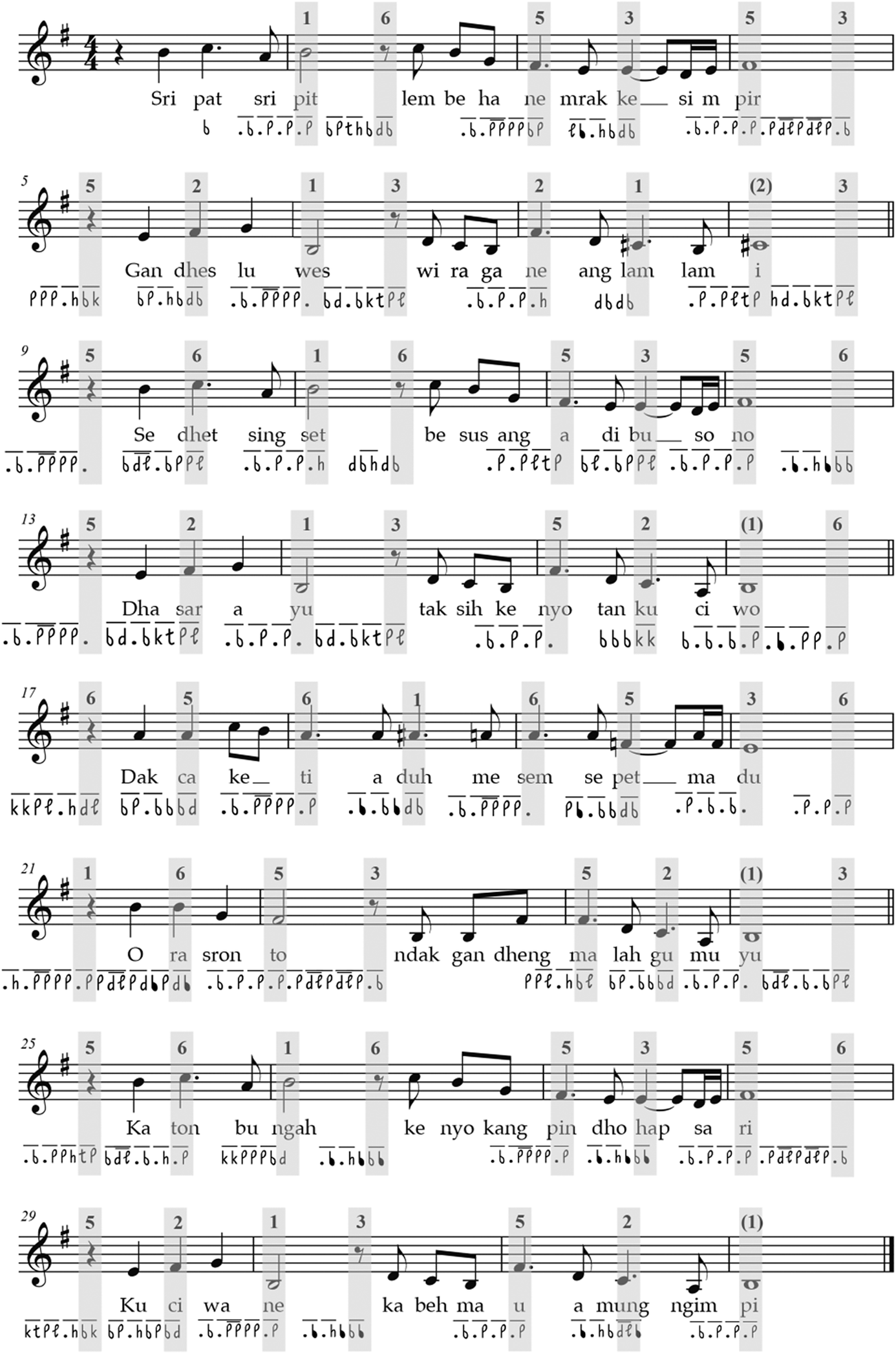
Figure 8. Transcription of Pak Edy playing selo once through the song form of “Ngimpi.”
There is a considerable amount of variation not only among the groups of musicians that we recorded, but also between the patterns used for kroncong selo and those used for kendhang gaya selo. All of the drummers we interviewed, although none were selo players themselves, were aware that kendhang gaya selo patterns are highly distinct from those played by kroncong selo. What gives kendhang gaya selo a selo-like character? Our interviewees explained that the trope of a repeating “thung” or “dah” leading up to the strong beat, evident in both transcriptions from Pak Edy and Pak Suwito, is the strongest indicator of the selo character in this style. In kroncong, these strong beats at the end of the vocal phrase are marked by the upright bass and in gamelan music they would be played by the kenong, kempul, or gong. Here are two examples from the full transcriptions for comparison.
When we compare, Pak Edy uses the “dhe” stroke whereas Pak Suwito uses another “thung” in the same place leading right up to the strong beat. The function of both strokes is the same and gives a similar feel, one that drummers cite as a selo-like feel. All of the players that we recorded employed variations of this pattern. Although some parallels are evident between the singgit/kenser patterns, as well as the fill-in/nampani andhegan patterns, the most consistent similarities were among the patterns in Figure 9 leading to the strong beat. While prior research from McGraw (Reference McGraw2022) examines differences in microtiming among kendhang players and selo players as a means of distinguishing the feel of both types of playing, we look at similarities and differences in the patterns played by kendhang players and selo players. These patterns happen persistently enough in kendhang gaya selo that they lend to an overall sense of the selo character in kendhang gaya selo.

Figure 9. Examples from Pak Edy and Pak Suwito’s full transcriptions demonstrate the selo character.
The Overall Character of Gaya Selo Kendhang
Many of the drummers that we interviewed consider gaya selo kendhang to be particularly appropriate for songs that are “trenyuh” or “mournful,” a word that describes a crushed or broken emotional state. Several drummers describe the song “Ngimpi” as “trenyuh” along with songs like “Kadhung Tresno” and “Impenku.” Pak Suyoto points out, however, that the lyrics to “Ngimpi” are not really sad, it is simply that song is miring meaning that, in gamelan settings, it uses a tonality that is sometimes perceived as melancholy. In the kroncong settings of “Ngimpi,” the song is played in a minor pelog approximation. Songs like “Kadhung Tresno” and “Impenku” also use this same tonality, and our interviewees considered them to be universally appropriate for gaya selo kendhang.
In addition, we asked each drummer to describe the overall character of gaya selo kendhang in comparison to pematut. Pak Suwito describes selo-style drumming as “lincah,” which translates to vivacious or agile (interview, 13 January 2023). Pak Dwijo Martono uses the Javanese word “sigrak” to describe kendhang gaya selo, which means “bursting with energy and buoyant health,”Footnote 19 reaffirming the liveliness that Pak Suwito describes. Both Pak Suwito and Pak Tlonteng describe kendhang gaya selo as “pernes” or charming, sometimes used to describe a light, flirtatious energy, usually with a connotation of femininity. Pak Tlonteng, however, also uses the word “tregel” to describe gaya selo kendhang, a term which refers to a more assertive, active kind of energy; it is associated with masculinity but not quite as strongly as pernes is associated with femininity (interview, 17 February 2023). For Pak Tlonteng, kendhang gaya selo is not associated with a particular gender characterisation, but is certainly associated with a dynamic energy. He says that the word tregel is typically used to describe movement as opposed to a style of instrument playing; dance movements, for instance, might be described as tregel. Pak Tlonteng finds tregel to be fitting in this context to describe what he saw as the energetic character of gaya selo kendhang.
Although several drummers describe kendhang gaya selo as possessing a certain buoyant energy, they all agree that pematut is better suited for dancing than kendhang gaya selo. In this instance, they are not referring to Javanese classical dance but instead to light dancing for entertainment, whether done by the pesindhen or by audience members. Javanese classical dance uses refined and choreographed movements whereas this kind of light dancing is improvisatory and may be done by an individual or small groups. As a relatively new song form, there are no classical dance forms associated with langgam Jawa but occasionally it is accompanied by this kind of improvised, casual dancing. At events such as weddings, there may be an opportunity for audience members to dance with the pesindhen, sometimes offering the pesindhen tips in a ritual practice known as saweran. Kendhang gaya selo is considered inappropriate or awkward for dancing, so if an event is moving in a livelier direction, drummers may choose pematut for langgam Jawa songs in order to allow for dancing.
The fact that drummers generally view pematut drumming as more appropriate to accompany movement and dancing seems somewhat at odds with notions of kendhang gaya selo as more “bursting with energy and buoyant health.” But some drummers characterise gaya selo differently, calling it more alus. Pak Widodo notes that gaya selo is more “mendayu” or lilting and more “mellow,” using the English word, while pematut is more bustling and lively (“ramai”) (interview, 22 February 2023). Pak Sigit Gapuk, besides describing kendhang gaya selo as more alus, also refers to it as “monoton,” using a borrowed English word to describe what he sees as a kind of monotonous, repetitive nature to this rhythmic treatment. Kendhang gaya selo does, in fact, generally repeat patterns more frequently than pematut. Yet Pak Sigit Gapuk also cites what he sees as a benefit of the somewhat more repetitive nature of this drumming style: the singing is more emphasised. Specifically, he employs visual metaphors to give an impression that kendhang gaya selo allows the vocal part to pop out and be featured, saying, “the vocals are more likely to be seen” and “the lyrics are more visible” (interview, 21 February 2023).Footnote 20 This is of central importance, particularly in the context of wayang performances, langgam Jawa songs are used as opportunities to feature the pesindhen and singers will often rise from their typical kneeling position to stand in front of the audience while they perform. Langgam Jawa appear most frequently during the gara-gara or limbukan scenes, interludes in wayang performances that employ comedic characters. Kendhang gaya selo in this case allows the vocalist and the lyrics of the particular langgam Jawa song to be showcased. However, as discussed above, gaya selo is seen as less appropriate for dancing and sometimes the pesindhen dance during these interludes perhaps leading the drummer to choose pematut.
Another factor that Pak Suwito and Pak Tlonteng mentioned for determining rhythmic treatment was whether the song had a lot of breaks or andhegan. “Ngimpi” was originally composed without an andhegan, as were songs like “Yen Ing Tawang” and “Nusul,” but over time andhegan have been added in, often for the function of giving the pesindhen an opportunity to interact with the audience or banter with the musicians before re-entering the song. In some songs, such as “Setyo Tuhu,” “Resepsi,” or “Ngalamuning Ati,” there is always an andhegan. In the case of “Ngalamuning Ati,” for example, the andhegan includes a long vocal flourish that cannot fit into the musical form unless there is a pause. Pak Suwito, although he suggests that kendhang gaya selo certainly can be used for songs with multiple andhegan, says that it can sometimes be “kejul” (“silly” or “comical”) (interview, 14 January 2023). Likewise, Pak Tlonteng notes that pematut was generally more appropriate for pieces that have several andhegan (interview, 17 February 2023). In contrast, the other drummers do not find any issues with using gaya selo in cases of multiple andhegan with Pak Wakidi suggesting that players who avoid gaya selo for this reason may just be “malas” (“lazy”).
Another element for consideration in the use of kendhang gaya selo is musical scale. All of the drummers agreed that langgam Jawa songs that employ slendro scales, such as “Caping Gunung” or “Ali-Ali,” are inappropriate for gaya selo. Pak Joko Suranto describes the use of kendhang gaya selo for songs using slendro scales as “wagu,” meaning “ungainly,” “awkward,” or “lacking tastefulness” (interview, 23 February 2023). Several drummers including Pak Darno and Pak Sigit say that the melodies for these songs were too horizontal or stepwise which was an aspect of what made them unsuitable for gaya selo. While most of the drummers feel that gaya selo is never appropriate for songs using slendro scales, Pak Tlonteng believes that one could potentially use this rhythmic treatment tastefully.
The songs “Caping Gunung” and “Ali-Ali” both happen to be originally composed for kroncong settings and were only later interpreted by gamelan players. “Yen Ing Tawang,” is another langgam Jawa piece, although in pelog as opposed to slendro, that was originally composed for kroncong settings. Opinions varied as to whether this piece was appropriate for kendhang gaya selo, but Pak Darno, Pak Wakidi, Pak Tlonteng, Pak Widodo, and Pak Sigit Gapuk all feel that pematut was the more fitting rhythmic treatment. This highlights what may seem at first like a contradiction: imitating the selo from kroncong in order to play a kroncong song is not ideal. The consensus was, however, that these songs already have a kroncong character and therefore the gaya selo treatment is redundant and less tasteful. The drummers that we interviewed posit that a contrast between the character of song and the character of the drumming is ideal. As shown in our analysis, the style of gaya selo kendhang drumming is most strongly indicated by the trope of a repeating thung or dah leading up to the strong beat.
Conclusion
Drummers make aesthetic choices about whether to use kendhang gaya selo or pematut with an aim to create contrast. The types of contrast take two main forms: contrast between the rhythmic treatments used during an overall performance, and contrast between the feeling of the song and the feeling of the drumming. The circularity of musical exchange from the kendhang, to the selo, and then back to the kendhang affords players with another rhythmic treatment with which they add contrast and variation. Pak Darno comments that, in the event that a drummer only uses one rhythmic treatment throughout a performance:
It’s definitely boring. Especially if the drummer can’t distinguish between songs that are appropriate for selo-style and pematut. Every langgam [Jawa] can be played with pematut and selo-style, but not all langgam [Jawa] are tasteful with pematut and selo-style. Some are tasteful when played in both styles, but some are only tasteful when played in pematut or only selo-style. It depends on the character of the song.Footnote 21
Pak Darno’s comments emphasise the importance of taste on behalf of the drummer, the importance of being able to distinguish between the most fitting rhythmic treatments, and part of this taste involved making decisions to alternate styles. During a casual latihan (rehearsal) in February 2023, one of the authors chose to sing “Ngimpi” followed by “Caping Gunung” while Pak Dwijo Martono played kendhang. He used gaya selo for “Ngimpi” followed by pematut for “Caping Gunung” explaining that it was best to alternate between the two styles (interview, 13 February 2023).Footnote 22 The use of gaya selo is partly contingent on what rhythmic treatment was played during the prior piece.
The drummers who chose to participate in this study agree that the use of gaya selo is contingent on the context, including the type of event (wedding, circumcision, wayang), the time (beginning of the day or the end of the day, beginning of the event itself or the end of the event itself), the song (“Caping Gunung,” “Kadhung Tresno,” and so forth), and whether the audience or the singer is dancing. There were trends to these decisions such as the general favouring of kendhang gaya selo for “Ngimpi” instead of “Caping Gunung” or the general favouring of kendhang gaya selo at the beginning of a wedding and pematut for the end of a wedding when guests may want to dance, but the drummers’ decisions are ultimately made in the moment based on a delicate balance of elements within the context they are playing.
In addition to the importance that drummers ascribed to overall contrast within a particular musical event, several drummers also describe the value of internal contrast between the feeling of the song and the feeling of the drumming. The drummers universally accept gaya selo kendhang for sad or melancholy songs which may seem at odds with the way some drummers perceive this style as “buoyant” or “energetic.” Drummers use words like “sigrak,” “tregel,” and “lincah” to describe the lively, active energy that they associate with gaya selo kendhang. Yet several drummers claimed that this contrast, between a sad song and lively drum accompaniment, is desirable. In reference to this seeming discrepancy, Pak Suwito comments that the agile, light-hearted nature of kendhang gaya selo is more appropriate for melancholy songs, for songs about difficult marriage or unrequited love (interview, 13 January 2023). To this point, Pak Wakidi notes that the liveliness of gaya selo is useful for heavier songs so that they “laugh a little bit” and “so that [the songs] don’t look too arduous” (interview, 13 February 2023).Footnote 23 He explains that gaya selo is ideal for songs like “Ngimpi” and “Kadhung Tresno” because it balances out the otherwise melancholy feeling of the songs. Kendhang players never claim to use gaya selo in order to make the piece sound selo-like, but instead for variation and balance within an event or within the piece itself, showing the way that the application of rhythmic treatments is part of a complex set of aesthetic negotiations.
Acknowledgements
This research was supported in part by a Fulbright-Hays DDRA Grant. The authors are grateful to the support from Institut Seni Indonesia Surakarta, AMINEF, Mas Yoga, and Mas Irvan for assistance with notation, Andy McGraw for comments on earlier drafts of this article, the two anonymous reviewers, and the generous musicians cited here for sharing their time and expertise.











